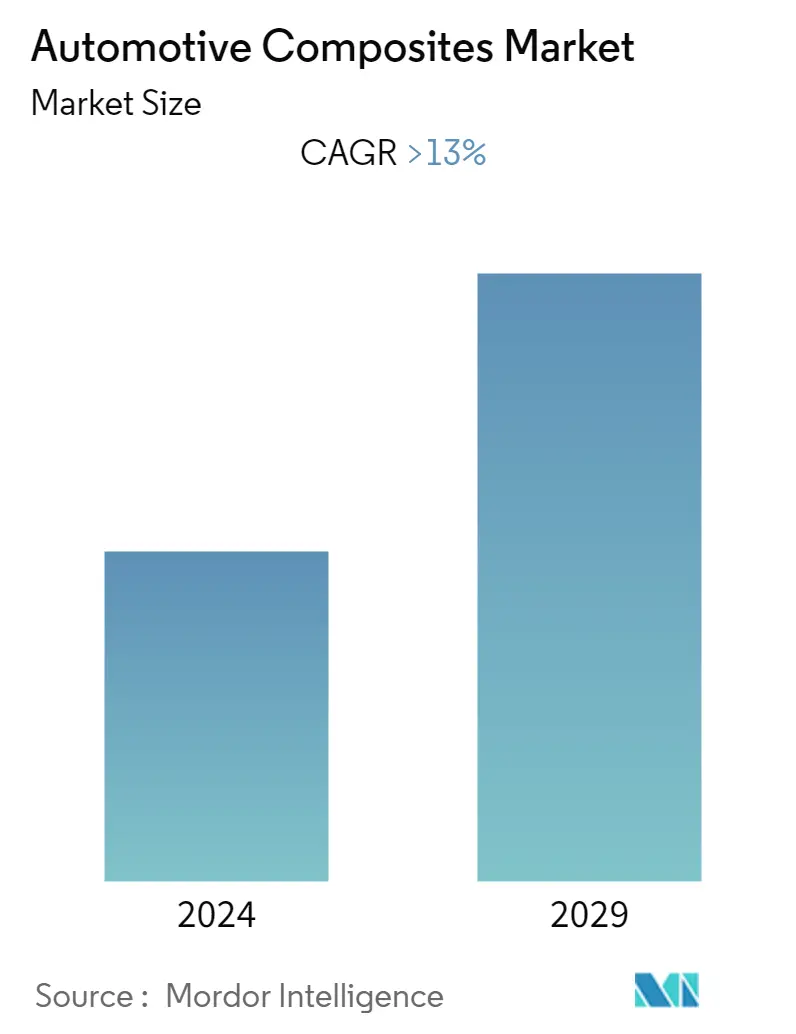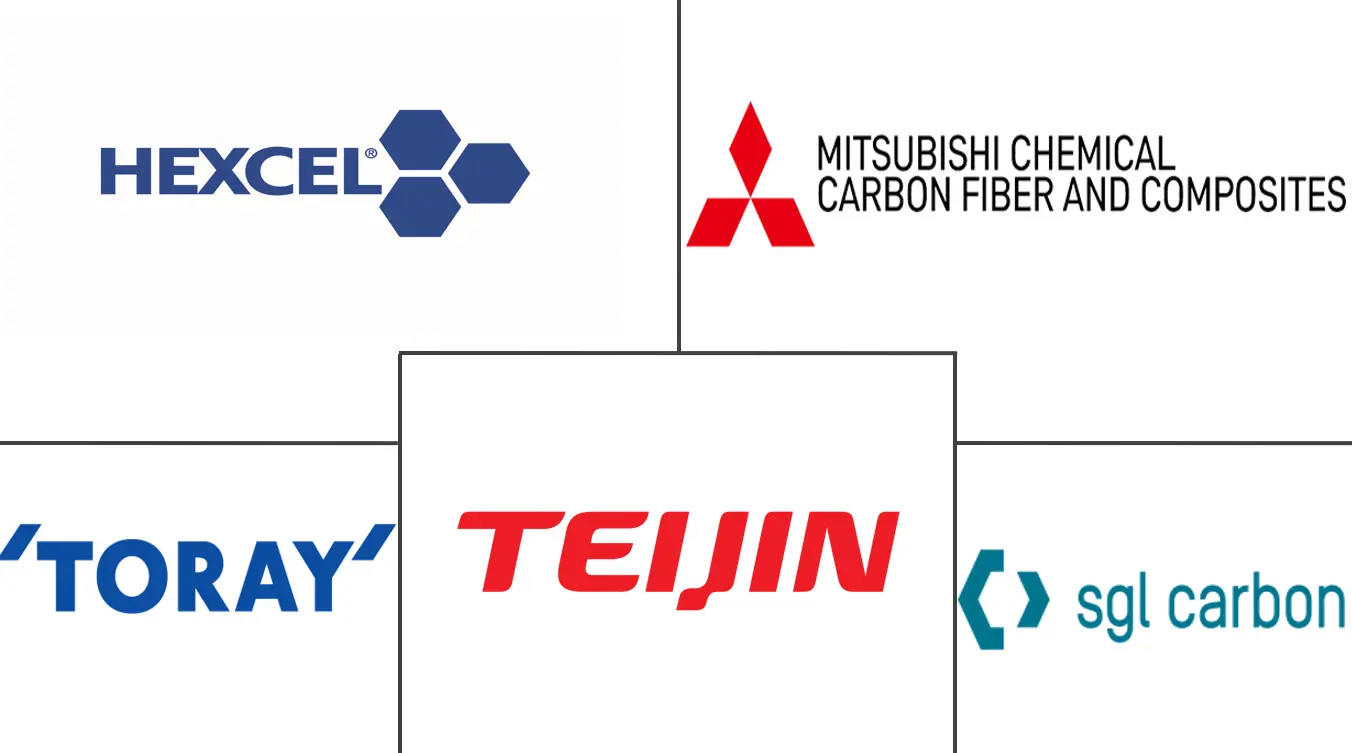Market Size of Automotive Composites Industry

| Study Period | 2019 - 2029 |
| Base Year For Estimation | 2023 |
| CAGR | 13.00 % |
| Fastest Growing Market | Europe |
| Largest Market | Asia Pacific |
| Market Concentration | Medium |
Major Players
*Disclaimer: Major Players sorted in no particular order |
Automotive Composites Market Analysis
The automotive composites market was valued at USD 27.12 billion in 2021 and is expected to reach USD 56.46 billion by 2027, registering a CAGR of over 13% during the forecast period 2022 - 2027.
Over the short term, the COVID-19 pandemic has had a negative impact on the market. With stringent lockdown and social distancing norms implemented across the world, the production of composite materials was severely affected. With the reduced number of vehicle sales worldwide, the market opportunity for composites to be used as different structures in vehicles was completely reduced.
Over the long term, Factors such as increasing demand for lightweight materials from the automotive industry and a growing focus on fuel economy are expected to be major drivers for the market. However, the high cost associated with carbon fiber composites and glass fiber composites is hindering the growth of the market. Usage of such composites in low-cost vehicles could increase the prices of such vehicles drastically.
The low recyclability of composites is also a restraint for their penetration in entry-level passenger vehicles. However, collaborations of the OEMs with suppliers (due to rising demand for fuel-efficient vehicles, growing lightweight electrical vehicle segment, and major automobile giants, like BMW and Nissan, trying to replace their existing metal parts with composite fibers) imply the scope and booming opportunity that the market is anticipated to offer over the forecast period.
Presently, composite materials, like thermoplastics and reinforced glass, have drawn the attention of carmakers, making them focus on sourcing better, tensile, and lighter components to manufacture automobile units.
Automotive Composites Industry Segmentation
Composites are being considered to make lighter, safer and more fuel-efficient vehicles. A composite is composed of a high-performance fiber (such as carbon or glass) in a matrix material (epoxy polymer) that when combined provides enhanced properties compared with the individual materials by themselves.
The automotive composites market is segmented by application type, by material type, and by geography.
By application type, the market is segmented as Structural Assembly, Powertrain Component, Interior, and Exterior. By Material Type, the market is segmented as Thermoset Polymer, Thermoplastic Polymer, Carbon Fiber, And Glass Fiber. By Geography, the market is segmented as North America, Europe, Asia-Pacific, and the Rest of the World.
| Application | |
| Structural Assembly | |
| Powertrain Component | |
| Interior | |
| Exterior |
| Material | |
| Thermoset Polymer | |
| Thermoplastic Polymer | |
| Carbon Fiber | |
| Glass Fiber |
| Geography | |||||||
| |||||||
| |||||||
| |||||||
|
Automotive Composites Market Size Summary
The automotive composites market is poised for significant growth, driven by the increasing demand for lightweight materials in the automotive industry. This demand is largely fueled by the need for improved fuel efficiency and adherence to stringent emission regulations globally. Despite the initial setbacks caused by the COVID-19 pandemic, which disrupted production and reduced vehicle sales, the market is expected to recover and expand. The focus on reducing vehicle weight to enhance driving dynamics and fuel economy is a key factor propelling the adoption of composites. However, the high costs associated with carbon and glass fiber composites, along with their low recyclability, pose challenges to their widespread use, particularly in entry-level vehicles. Collaborations between original equipment manufacturers (OEMs) and suppliers are expected to create opportunities for integrating composites into more vehicles, as major automotive players seek to replace metal parts with lighter composite materials.
The market landscape is characterized by a strong presence in the Asia-Pacific region, followed by Europe and North America, with India emerging as a significant player due to its expanding automotive industry and rising consumer awareness about fuel efficiency. The demand for customized and high-performance vehicles, such as sports and racing cars, is also contributing to the market's growth, as these vehicles have long utilized thermoset composites. Key industry players, including Mitsubishi Chemical, Toray Industries, and SGL Carbon, are actively developing innovative composite materials to meet the evolving needs of the automotive sector. These advancements are expected to drive the market towards exponential growth, as manufacturers strive to meet higher fuel economy standards and reduce vehicle emissions.
Automotive Composites Market Size - Table of Contents
-
1. MARKET DYNAMICS
-
1.1 Market Driver
-
1.2 Market Restraint
-
1.3 Industry Attractiveness - Porter's Five Forces Analysis
-
1.3.1 Threat of New Entrants
-
1.3.2 Bargaining Power of Buyers/Consumers
-
1.3.3 Bargaining Power of Suppliers
-
1.3.4 Threat of Substitute Products
-
1.3.5 Intensity of Competitive Rivalry
-
-
-
2. MARKET SEGMENTATION
-
2.1 Application
-
2.1.1 Structural Assembly
-
2.1.2 Powertrain Component
-
2.1.3 Interior
-
2.1.4 Exterior
-
-
2.2 Material
-
2.2.1 Thermoset Polymer
-
2.2.2 Thermoplastic Polymer
-
2.2.3 Carbon Fiber
-
2.2.4 Glass Fiber
-
-
2.3 Geography
-
2.3.1 North America
-
2.3.1.1 United States
-
2.3.1.2 Canada
-
2.3.1.3 Rest of North America
-
-
2.3.2 Europe
-
2.3.2.1 Germany
-
2.3.2.2 United Kingdom
-
2.3.2.3 France
-
2.3.2.4 Italy
-
2.3.2.5 Rest of Europe
-
-
2.3.3 Asia-Pacific
-
2.3.3.1 China
-
2.3.3.2 Japan
-
2.3.3.3 India
-
2.3.3.4 South Korea
-
2.3.3.5 Rest of Asia-Pacific
-
-
2.3.4 Rest of the World
-
2.3.4.1 South America
-
2.3.4.2 Middle-East and Africa
-
-
-
Automotive Composites Market Size FAQs
What is the current Automotive Composites Market size?
The Automotive Composites Market is projected to register a CAGR of greater than 13% during the forecast period (2024-2029)
Who are the key players in Automotive Composites Market?
Hexcel Corporation, Mitsubishi Chemical Carbon Fiber and Composites, Inc., SGL Carbon, Toray Industries Inc and Teijin Ltd are the major companies operating in the Automotive Composites Market.

